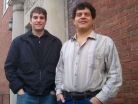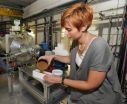(Press-News.org) Scientists can't travel deep space the way Columbus sailed and charted the New World or Lewis and Clark mapped the west. But, researchers at Case Western Reserve University and two partnering institutions have found a possible way to map the spread and structure of the universe, guided by the light of quasars.
The technique, combined with the expected discovery of millions more far-away quasars over the next decade, could yield an unprecedented look back to a time shortly after the Big Bang, when the universe was a fraction the size it is today.
Researchers found the key while analyzing the visible light from a small group of quasars.
Patterns of light variation over time were consistent from one quasar to another when corrected for the quasar's redshift. This redshift occurs because an expanding universe carries the quasars away from us, thus making the light from them appear redder (hence the term), and also making the time variations appear to occur more slowly.
Turning this around, by measuring the rate at which a quasar's light appears to vary and comparing this rate to the standard rate at which quasars sampled actually vary, the researchers were able to infer the redshift of the quasar.
Knowing the quasar redshift enables the scientists to calculate the relative size of the universe when the light was emitted, compared to today.
"It appears we may have a useful tool for mapping out the expansion history of the universe," said Glenn Starkman, a physics professor at Case Western Reserve and an author of the study, published this summer in Physical Review Letters.
"If we could measure the redshifts of millions of quasars, we could use them to map the structures in the universe out to a large redshift."
The larger the redshift, the farther and older the light source.
The group plans to seek larger samples of quasars, to confirm the patterns are consistent and can be used to calculate their redshifts everywhere across the universe.
The work was led by De-Chang Dai, who earned his PhD working with Starkman and was most recently a member of the Astrophysics, Cosmology and Gravity Centre, University of Cape Town. The other authors include Amanda Weltman, PhD, a senior cosmology lecturer at the Centre, and brothers Branislav Stojkovic, a doctoral student in computer science and engineering, and Dejan Stojkovic, a physics professor at the State University of New York at Buffalo. Dejan Stojkovic also earned his PhD with Starkman and was later a visiting assistant professor at Case Western Reserve.
The scientists graphed the amount of light from 14 quasars recorded by the Massive Compact Halo Objects project, which sought evidence of dark matter in and around the Milky Way. Light from each quasar was measured repeatedly over hundreds of days.
Graphing revealed phases during which the amount of light would either increase or decrease in a linear fashion over an extended period of time.
Although other properties varied, the rate at which the measurable light changed was nearly identical among all 14 quasars, once scientists corrected for the effects of the universe's expansion.
"It's as if there was a dimmer switch on them with someone turning it to the left then the right," Starkman said. "The overall trend was surprisingly consistent."
This consistency of patterns enabled the scientists to accurately calculate the cosmological redshift of one quasar from another.
The researchers tested this capability in two ways.
They fit segments of the light curves, that is, the measured light over time, to straight lines. The slopes of the lines were consistent and appeared to be directly related to the quasars' redshifts.
By comparing corresponding slopes of 13 quasars with a known redshift value to the slopes of one other quasar, the researchers could calculate the redshift of the lone quasar within two percentage points.
In a second approach, the researchers took large sections of the light curves of two quasars and concentrated on the segments that matched most closely. By varying the ratio of the redshifts of the two quasars to try to get the best possible match of the two light curves, they were able to determine the ratio of the quasars' redshifts to within 1.5 percentage points.
Astronomers have used the bright light of supernovae with redshifts up to about 1.7 to measure the accelerating expansion of the universe. A star with a redshift of 1.7 would have been emitting that light when the universe was 2.7 times smaller than today.
Quasars are older and farther away and have been measured with redshifts of up to 7.1, which means they emitted the light we are seeing when the universe was as small as one-eighth the size it is today.
If this method of determining quasar redshifts proves applicable to higher redshift quasars, scientists could have millions of markers to trace the growth and evolution of structure and the expansion of the universe out to large distances and early times.
"This could help us learn about how gravity has assembled structure in the universe." Starkman said. "And, the rate of structure growth can help us determine whether dark energy or modified laws of gravity drive the accelerated expansion of the universe."
### END
Quasars: Mileposts marking the universe's expansion
2012-09-18
ELSE PRESS RELEASES FROM THIS DATE:
CEO incentives should be more strategic
2012-09-18
EAST LANSING, Mich. — CEOs are sometimes rewarded for taking excessive risks – a practice that helped fuel the recent recession but could be altered if companies are more strategic in how they compensate their chief executives, a Michigan State University scholar argues in a new study.
Instead of issuing stock and stock options in predetermined quantities, boards of directors should vary a CEO's equity-based compensation through a plan that fosters the amount of risk-taking the firm desires, said Robert Wiseman, chairperson and professor in MSU's Department of Management.
The ...
Light drinking may relate to increase in risk for certain cancers
2012-09-18
The majority of observational studies have shown that alcohol intake, especially heavy drinking, increases a number of upper-aero-digestive tract (UADT) and other cancers, and even moderate drinking is associated with a slight increase in the risk of breast cancer. A meta analysis published in the Annals of Oncology compares the effects between light drinkers (an average reported intake of up to 1 typical drink/day) versus "non-drinkers" in terms of relative risks for a number of types of cancer.
The authors concluded that while the risk of these cancers was only slightly ...
How much product information do consumers want?
2012-09-18
PROVIDENCE, R.I. [Brown University] — A study published online in the Journal of Consumer Research finds that people can differ widely on the level of detail makes them feel they understand something. In experiments, the very same explanations that some subjects required before they would pay top dollar seemed to drive down what others were willing to pay. The natural trick for a marketer would be to figure out which customers are which. The study does that, too.
"The fact is that people differ," said Steven Sloman, professor of cognitive, linguistic, and psychological ...
Study provides roadmap for delirium risks, prevention, treatment, prognosis and research
2012-09-18
INDIANAPOLIS -- Delirium, a common acute condition with significant short- and long-term effects on cognition and function, should be identified as an indicator of poor long-term prognosis, prompting immediate and effective management strategies, according to the authors of a new systematic evidence review.
"Delirium is extremely common among older adults in intensive care units and is not uncommon in other hospital units and in nursing homes, but too often it's ignored or accepted as inevitable. Delirium significantly increases risk of developing dementia and triples ...
Seeing fewer older people in the street may lead low-income adults to fast-track their lives
2012-09-18
Why do people in deprived areas live life in the fast lane? It may be because of the age of people they observe in the street, according to a new study by Daniel Nettle and colleagues from Newcastle University in the UK. Their work suggests that because fewer older people are seen out in the street in deprived neighborhoods, younger generations assume that people die young. As a result, they may be adapting the speed at which they live their lives accordingly—for example, by having children earlier in life. Nettle and team's work is published online in Springer's journal ...
Early menopause associated with increased risk of heart disease, stroke
2012-09-18
Women who go into early menopause are twice as likely to suffer from coronary heart disease and stroke, new Johns Hopkins-led research suggests.
The association holds true in patients from a variety of different ethnic backgrounds, the study found, and is independent of traditional cardiovascular disease risk factors, the scientists say.
"If physicians know a patient has entered menopause before her 46th birthday, they can be extra vigilant in making recommendations and providing treatments to help prevent heart attacks and stroke," says Dhananjay Vaidya, Ph.D., an ...
Oral bacteria may signal pancreatic cancer risk
2012-09-18
PROVIDENCE, R.I. [Brown University] — A new study finds significant associations between antibodies for multiple oral bacteria and the risk of pancreatic cancer, adding support for the emerging idea that the ostensibly distant medical conditions are related.
The study of blood samples from more than 800 European adults, published online Sept. 18 in the journal Gut, found that high antibody levels for one of the more infectious periodontal bacterium strains of Porphyromonas gingivalis were associated with a two-fold risk for pancreatic cancer. Meanwhile, study subjects ...
Substance-use disorders linked to increased risk of death for veterans with PTSD
2012-09-18
Veterans suffering from post-traumatic stress disorder who are also battling drug or alcohol problems face a higher risk of death, according to new research from the University of Michigan Health System and the VA Ann Arbor Healthcare System.
The new study is the first to examine the association between drug or alcohol use disorders and death in veterans with PTSD, and also includes data from the nation's youngest veterans who have returned from conflict in Iraq and Afghanistan.
Kipling Bohnert, Ph.D., the study's lead author, says the research sheds new light on the ...
Precision motion tracking -- thousands of cells at a time
2012-09-18
Researchers have developed a new way to observe and track large numbers of rapidly moving objects under a microscope, capturing precise motion paths in three dimensions.
Over the course of the study--reported online Sept. 17, 2012, in the Proceedings of the National Academy of Sciences--researchers followed an unprecedented 24,000 rapidly moving cells over wide fields of view and through large sample volumes, recording each cell's path for as long as 20 seconds.
"We can very precisely track the motion of small things, more than a thousand of them at the same time, in ...
Protection for humans on Mars
2012-09-18
This press release is available in German.On Earth the atmosphere and the magnetic field weaken cosmic rays. But on Moon and Mars they pelt down unhamperdly. The cosmic radiation can harm astronauts and could cause cancer in the long run as a result of damage in DNA and cells.
Chiara La Tessa is manager of experiments in GSI biophysics. She explains why Moon or Mars ground stations would not be built from terrestrial high tech material: "In space travels every gram counts. Transporting building material through space would lead to a cost explosion. That is why ground ...




